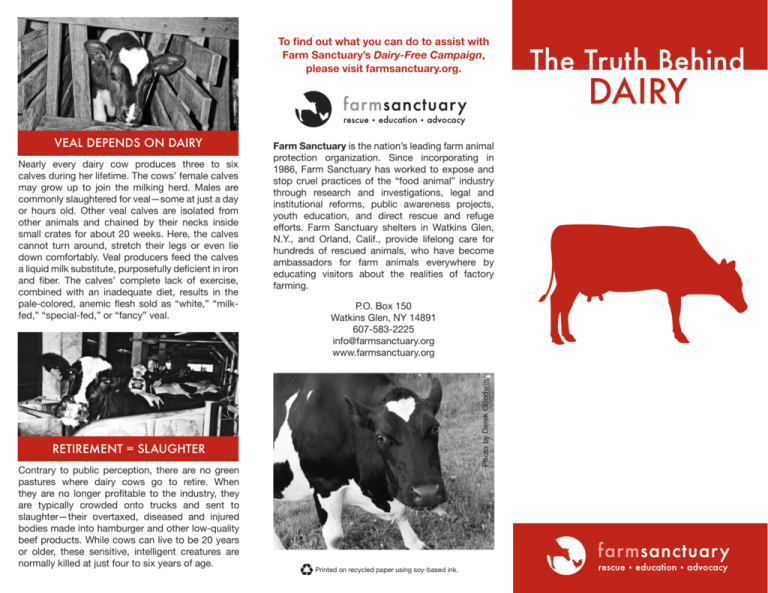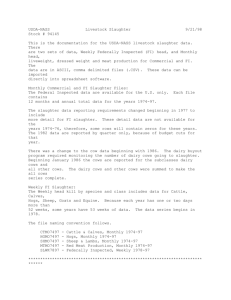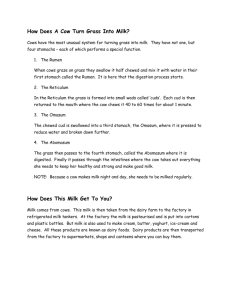The Truth Behind
advertisement

To find out what you can do to assist with Farm Sanctuary’s Dairy-Free Campaign, please visit farmsanctuary.org. Nearly every dairy cow produces three to six calves during her lifetime. The cows’ female calves may grow up to join the milking herd. Males are commonly slaughtered for veal—some at just a day or hours old. Other veal calves are isolated from other animals and chained by their necks inside small crates for about 20 weeks. Here, the calves cannot turn around, stretch their legs or even lie down comfortably. Veal producers feed the calves a liquid milk substitute, purposefully deficient in iron and fiber. The calves’ complete lack of exercise, combined with an inadequate diet, results in the pale-colored, anemic flesh sold as “white,” “milkfed,” “special-fed,” or “fancy” veal. Farm Sanctuary is the nation’s leading farm animal protection organization. Since incorporating in 1986, Farm Sanctuary has worked to expose and stop cruel practices of the “food animal” industry through research and investigations, legal and institutional reforms, public awareness projects, youth education, and direct rescue and refuge efforts. Farm Sanctuary shelters in Watkins Glen, N.Y., and Orland, Calif., provide lifelong care for hundreds of rescued animals, who have become ambassadors for farm animals everywhere by educating visitors about the realities of factory farming. P.O. Box 150 Watkins Glen, NY 14891 607-583-2225 info@farmsanctuary.org www.farmsanctuary.org Photo by Derek Goodwin VEAL DEPENDS ON DAIRY RETIREMENT = SLAUGHTER Contrary to public perception, there are no green pastures where dairy cows go to retire. When they are no longer profitable to the industry, they are typically crowded onto trucks and sent to slaughter—their overtaxed, diseased and injured bodies made into hamburger and other low-quality beef products. While cows can live to be 20 years or older, these sensitive, intelligent creatures are normally killed at just four to six years of age. Printed on recycled paper using soy-based ink. The Truth Behind dairy To meet consumer demand for milk, most dairy cows in the U.S. are continually impregnated, fed unnatural diets and intensively confined— their short lives plagued by painful infections, calcium-depletion and lameness. Far from being the “happy cows” the dairy industry markets them to be, these animals endure immense suffering on factory farms. • Many dairies inject cows with recombinant bovine growth hormone (rBST), a geneticallyengineered hormone used to boost milk production. This hormone contributes to the suffering of millions of animals, and even the FDA admits that it increases cows’ risk for mastitis, severe reproductive problems, digestive disorders, foot and leg ailments, and persistent sores. downed animals – especially instances in which animals were dragged with chains and pushed with tractors or forklifts – the USDA announced a new rule prohibiting the slaughter of all disabled non-ambulatory cattle, and mandating that those animals be humanely euthanized. • Production requires maximum energy from cows. Most producers compensate for energy loss by feeding the animals high-calorie, grain-based diets. Cows, however, have difficulty digesting grain, and these diets can lead to bloat, stomach ulcers, liver abscesses, metabolic disorders, and deadly bacteria growth. A VICIOUS CYCLE Like all mammals, dairy cows must become pregnant or give birth in order to produce milk. Most cows are artificially inseminated once a year and, following physically demanding nine-month-long pregnancies, are almost immediately separated from their calves. The cows’ milk—meant for their babies—goes to the dairy industry. Milking begins as soon as the cows’ calves are born and continues for about 10 months. During their second month of milking, the cows are usually re-impregnated. The impregnation-lactation cycle normally continues for three to five years. When the cows’ overall milk production declines, they are typically slaughtered. RAMPANT ILLNESS AND DISEASE Today’s cows have been bred to produce unnatural quantities of milk—the amount per cow more than quadrupling since 1925. The enormous strain of commercial milk production quickly makes healthy cows sick. When these animals become so ill or injured that they are no longer profitable to the dairy industry, they are pulled from the herd, and sent to slaughter. The top three reasons why cows are slaughtered include: mastitis (an extremely painful udder infection), lameness and reproductive problems. • Milk fever, another common and potentially fatal illness that afflicts dairy cows, is caused by calcium deficiency—a result of their having to produce an excessive amount of milk while pregnant. BIGGER FARMS, BIGGER PROBLEMS Most small dairy farms have been replaced by factory dairies that operate on dry lots, huge enclosed areas that confine hundreds or thousands of cows. The animals raised on these lots live on dirt instead of pasture and have little shelter from the elements. Dry lot dairies in western states now produce more than half of the U.S. milk supply. • Between 2000 and 2006, the number of farms with less than 200 cows decreased by more than 40 percent, while the number of farms with at least 1,000 cows more than doubled. HOW NOW, DOWNED COW? Due to the grueling conditions in which they are raised, dairy cows become “downed” more than any other kind of livestock. Weak, calcium-depleted dairy cows often slip and fall en route to slaughter, or are so badly injured or sick that they are unable to walk or even stand on their own. Many of these “downer” cows languish without food, water or veterinary care for hours, sometimes days, as they await slaughter. Finally after years of investigations detailing the improper handling, neglect and abuse of • In 1925, there were 21.5 million dairy cows in the U.S., each of whom produced an average of 4,200 pounds of milk a year. By 2007, the number of dairy cows dropped to around nine million, while milk production per cow quadrupled to an average of 20,260 pounds of milk annually. • These large facilities give rise to big problems for the environment. Waste from dairy farms is funneled into massive lagoons or cesspools. These pits, some the size of football fields, emit huge amounts of greenhouse gases and can leach into the soil, contaminating groundwater and damaging local ecosystems. Worldwide, dairy cattle generate more than 20 million tons of methane gas through normal digestion and manure production alone.





